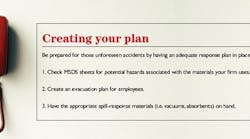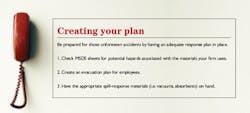When your 3,000-gal. holding tank ruptures, it's way too late to start developing an emergency response plan. Controlling a spill requires immediate action and having a plan as well as trained workers to carry it out.
A strong plan minimizes environmental harm and facility downtime. Although container, vessel and piping manufacturers strive to ensure the physical integrity of their products, and the odds of rupture may seem remote, the fact remains that even the best-designed containment system can leak. Drums and totes can be damaged in transit. Forklift drivers can stab a drum. Vandals can open a block valve. It's essential to foresee problems and develop a plan so that everyone knows what to do when a problem occurs.
|
View related content on PlantServices.com |
Assess the potential
Before starting a plan, determine which materials are on-site and where they're stored. Consider every chemical, from bulk materials for processes to liquid floor wax for an entranceway. Determine where each chemical goes once it arrives at the dock. Find out whether it's used immediately or stored. Don't neglect cleaning chemicals stored in remote areas, waste containers that are stored before shipment, or areas where forklift batteries are recharged and refilled.
Using a plant layout drawing as a guide, walk through the facility and map potential spill hazards. Mark areas where chemicals are stored or used. Note the names of the chemicals and container volumes. Also consider outdoor tanks both above and underground. Mark the location and routing of piping from tanks or totes, which can leak or rupture. Locate floor drains that lead to public sewer systems or bodies of water that may need to be guarded to prevent environmental harm in the event of a spill.
Purchasing agents and receiving clerks can be good sources of information about chemicals in the plant. Compare findings from your walkthrough with lists of materials that were purchased or received. Investigate any discrepancy between the lists and reality.
Determine the hazard
Determine the potential for harm using relevant Material Safety Data Sheets (MSDS) or other safety information to identify corrosives and flammable materials. Check the data sheets to determine if any of the chemicals are incompatible if mixed.
The data sheets usually provide general spill-response and safety information. If the information isn't clear, or if a specific question arises, consult the chemical's manufacturer, whose phone number should be listed in Section One of the data sheet.
Even if the material itself is not inherently hazardous, spills can still pose problems. For example, a 300-gal. tote of corn syrup isn't corrosive, nor is it a fire risk. It will, however, produce a large, sticky mess if a valve breaks or a seam ruptures. If left unattended, it also attracts insects and animals.
Acknowledge that hazards may be different throughout the facility, and separate planning elements may be needed for each area. For example, flammable liquids may be stored in one area, bulk powders in another. Each area is hazardousthe first faces flammability issues, the second, engulfment hazards (materials that may break loose and engulf and suffocate a worker). Clearly, different spill-response plans will be needed for these areas.
In addition to the hazard created by the sheer presence of a spill, look for potential danger to employees or the community. Determine if employees will need to evacuate, and identify the precautions they have to take. Establish exit routes for quick, safe evacuation. Consult with local fire departments or hazardous-materials response teams when developing your plan since they will be needed to assist if an accident occurs and public evacuation is necessary.
Gather resources
Look for safety materials and resources already on-site. Ensure that the maintenance department has necessary absorbents on hand. Make vacuums available. Find out who has already received spill-response training.
Determine what spill response equipment would be needed and where it should be stored. If spills are likely to occur at the receiving dock, be sure to store a spill-response kit there. If totes are stored in an area near floor drains, have drain covers nearby. If it's not practical to absorb an entire spill, determine what equipment (dikes, bulldozers, industrial-sized vacuums) will be needed and where it can be stored.
Assemble a cross-disciplinary team of workers and managers from various areas. Discuss findings with them and enlist their help in designing a spill response plan. Because these people work in different areas and have different process knowledge, they will be able to add insight regarding potential problems that may have been overlooked in the initial walkthrough.
Make the plan
Good response plans ensure everyone's safety in the event of a spill. Document the procedures that employees should take. It's not practical or possible to train everyone to be full-blown spill responders. However, employees should know what to do if they see a spill pull an alarm, alert a supervisor, attempt to dike the spill so it doesn't spread.
Determine best practices and write them into the plan. For those who will be responding to a spill, document the safety procedures to be taken before, during and after response.
The plan should outline the specific steps to take for any spill that could occur. The response to a leaky drum of hydraulic oil at the loading dock will be quite different from that for a broken pressurized sodium hydroxide line. List general steps, such as confining the spill first, then itemize hazard-specific actions to be taken next.
Include a list of materials that are available for spill response, as well as their locations. Make preparations to inspect these materials periodically to ensure that stock levels are still adequate and that any mechanical gear is in working order.
If outside help such as fire or police departments will be needed, list their responsibilities and abilities in the plan. Provide needed names and phone numbers, as well as any information that these agencies will require.
Determine what steps need to be taken after a spill is cleaned up. Spill kits and personal protective equipment may need to be re-stocked. Process equipment may need to be inspected for damage, and parts may need to be replaced before equipment can be restarted. Wastes will need proper handling and disposal. Reports may need to be filed. Realizing these elements ahead of time helps ensure safety.
Training
After developing and documenting a plan, train employees, even those who are not directly involved in the response.
Office workers, who may never see a spill, still need to know when and where to evacuate. Establish the signal to be used an announcement over the intercom or a siren, perhaps different signals for different emergencies, or the same alarm for every emergency. Show everyone the evacuation route they should take and exactly where they should go. Produce a written employee roster and assign people to perform a roll call at the evacuation site. Don't forget to account for visitors who may be on-site. A receptionist's or security log can be used for this purpose.
The staff who would respond to the spill will need additional training, including spill identification, using safety equipment and proper response techniques. These individuals should drill regularly so that when a spill occurs, the response plan and procedures will be familiar and automatic.
Post-mortems
After drills or spills, review what has happened and focus on weaknesses. If everything didn't go according to plan, make changes so that the same mistakes won't happen again. Document the changes and drill them to confirm their adequacy.
Even if a drill goes smoothly, review the plan annually to ensure its elements are still up to date. Amend the plan when people retire or change positions. Change it to accommodate equipment or process changes. Verify that outside contact names and phone numbers, such as fire department contacts and equipment rental companies, are still valid.
Reaping what you sow
When a spill occurs, the first few minutes are the most critical. Although producing a spill-response plan may take a lot of time and effort, the benefits far outweigh the costs. Being prepared for spills ensures worker safety, minimizes downtime and reduces environmental damage.
Karen D. Hamel is a technical specialist for New Pig Corp. Contact her at [email protected] or (800) 468-4647 x 2196.

